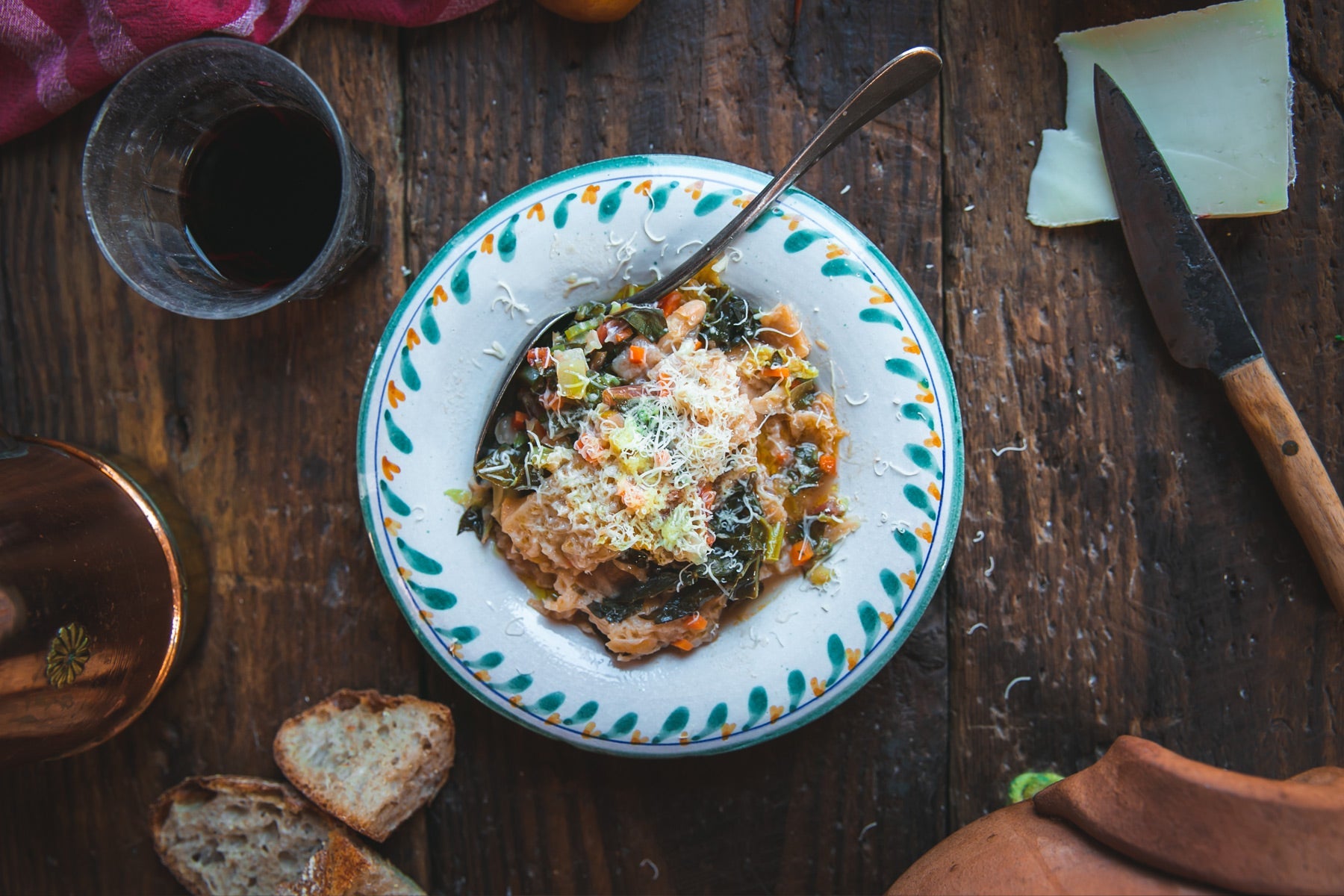Ribollita a Tuscan Peasant Dish

Ribollita a Tuscan Peasant Dish
Recipe:
Ribollita is one of the most traditional winter soups of Tuscan cuisine, and the people of Florence claim it as their own. Many comfort foods have truly humble beginnings, as they are born in a kitchen where only seasonal gifts from the garden are used, and leftovers never go to waste. This is exactly how Ribollita has its origins, coming from a peasant kitchen where Cavolo Nero is abundant in the winter and even stale day old bread is put to good use as it gives this soup the characteristic thick consistency. Finally everything is patiently prepared into a heart warming dish.
Italians love to give very specific descriptions to dishes they make, and soups are no exception. From creamed soups to hardy vegetable soups, as well as thick stews accompanied by gifts from the sea, and meat soups with vegetables or mushrooms, and the list continues. Ribollita, just as many other soups are thickened up by slices of stale bread soaked into the dish.
Now what is the meaning of RIBOLLITA, and is it a soup or a stew? Ribollita means 'reboiled'. Just as many other soups, Ribollita is thickened up by slices of stale bread soaked into the dish. It is prepared the day before and the bread slices are layered between ladles of vegetables, beans and broth, and these soak up all the broth overnight. The next day this hardy vegetable stew is once again reboiled and served into a delicious, thick and hardy stew topped off with a good drizzle of good extra virgin olive oil and a dusting of Grana or Parmigiano Reggiano. Let's get started!
Supplies:
- Wood Fired Pizza Oven
- Large pot
- Terra-cotta cooking pot
Ingredients:
- 400 grams day old tuscan bread sliced thinly
- 400 grams cannelini beans - either from the can or dry beans rehydrated the night before
- Half a Savoy cabbage - cavolo verza
- 1 bunch lacinato kale - cavolo nero
- 1 bunch Swiss chards - bietole
- 2-3 fresh medium tomatoes or a small can of peeled Roma tomatoes
- 1 tablespoon tomato paste
- 3 celery sticks minced
- 3 carrots minced
- 1 large onion minced
- 2 cloves garlic
- 1 leak
- 1 large zucchini
- 2 sprigs fresh thyme
- Handful chopped parsley - reserve some for serving
- A chunk of parmigiano reggiano crust - optional
- 1 liter broth of your choosing
- 1 liter water
- Cayenne pepper flakes to taste - optional
- Salt and pepper to taste
- 3 Tablespoons olive oil
Directions:
- Preheat the cast iron stove top of the Wood Fired Pizza Oven.
- Mince the carrots, onions, and celery. Crush the garlic. Chop the cabbage, Swiss chard, cavolo nero, leaks and parsley. Dice the potatoes and zucchini.
- Cream 1/3 of the beans with an immersion blender, leaving the rest whole. Set aside.
- Drizzle the olive oil into the preheated pan. Add the carrots, onions, celery and hot pepper flakes. Allow everything to sauté.
- Stir in the garlic, allowing it to sizzle and the aroma to be released.
- Add the zucchini, potatoes and the leaks. Cook down with their juices on medium heat.
- Season with salt, parsley, the sprigs of thyme and the whole Parmigiano crust. In Italy not even the crust of the cheese is waisted as it is incorporated in soups to add a delicious flavor. The cheese still present on the crust will soften and is a treat worth fighting for.
- Mix in the Swiss chard, cavolo nero, and cabbage. Cover the greens completely with broth and the water. Allow to simmer for at least one to two hours.
- After the time is up, add the beans, the creamed beans, tomatoes and tomato paste. Simmer gently and stir occasionally as the beans tend to stick to the bottom of the pan for about 15-20 minutes.
- Finally, add a ladle or two of the soup to the terra-cotta pot or dutch oven, then cover with a few pieces of the sliced bread. Continue layering and alternating soup and bread until the pot is filled. Allow it to simmer for a few minutes.
- Set the pot on the countertop and allow the bread to soak up the liquid overnight.
- The next day the stew can be reboiled by placing it in the oven or over the stove top as it simmers until hot. The ribollita is now ready to be served and enjoyed immediately. Accompany with a good dusting of Parmigiano Reggiano and a generous drizzle of good olive oil. It is also delicious when puréed with an immersion blender. Enjoy!
Buon Appetito!
Subscribe to our YouTube channel for more videos!
Follow us on Instagram and tag us with your culinary magic! We would love to see how you make this recipe!



